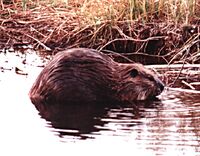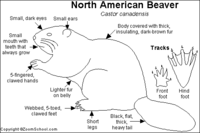Water chipmunks
| Water Chipmunk | |
|---|---|
 | |
| Scientific classification | |
| Kingdom | Shit Maker |
| Phylum | Chordata |
| Class | Mammal |
| Order | Herbivore |
| Family | Castor |
| Genus | Mutensis |
| Species | Suckis Anusus |
| Binomial name | |
| Shitmonk | |
| Specifications | |
| Primary armament | 2d8+4, tackle |
| Secondary armament | 1d1+4 |
| Power supply | Ugly |
| Health | 15 |
| Mana | 0 |
| Strength | 3 |
| Intelligence | 3 |
| Weight | 15 lbs. |
| Length | (1'5)-(3'5) Ft |
| Special attack | Cancer |
| Conservation status | |
| Common to North America | |
The water chipmunk gained its name because of the nature of its young. The young can be identified as chipmunk-like creatures swimming in shallow bodies of water, such as puddles, inflatable swimming pools, and toilets. The young are not dangerous, except to each other, because they are born by the hundred, and only the strongest survive by eating their brutish contemporaries. The Giant Mutant Herbivore South American Flat Tailed Water Chipmunks (Castor mutensis also henceforth known as the GMhSAFTWC).
The GMHSAFTWC is a not-so-distant relative of the North American beaver, a partially aquatic dwelling mammal that likes to bite at trees in order to nourish itself. There has been talk of beavers tending toward cannibalism, but this is purely speculation. The genesis of Castor mutensis is a curious one indeed, full with adventure, guesswork, and Tarantino-worthy gore.
The Origin of the Species[edit]
The story of the conception of Castor mutensis begins with the appearance of a renowned professor of North American Mammal History at Stanford University. This professor, known as William Butler Yeats, was an avid researcher of evolutionary trends in the Canadian beaver which is slightly rarer than those in the USA. He decided to insert beavers into a completely alien environment in order to observe their development and possibly create the water chipmunks.
The Beginning of the Yeats' Study[edit]
Here is an excerpt from the diary of the professor himself:
| “ | I was in search of beavers, and beavers I found. They lived together in a dam along a stream adjoining the property, not far from a lake. I've been renowned in tracking skills- I've been following beavers my whole life. I got my best lead so far by following a trail of gnawed tree stumps in order to find their lair. It was a solid structure, all twigs and intricately tangled branches, with an underwater entrance. I carefully waded into the shallows with Panda, the dog. With a whispered order, gave the bitch a small metal devise of her own conception (And I do not mean conception or intercourse with the GMHAFTWC). The bitch took it placidly in her jaws and swam away, disappearing from view for a moment, then emerging some way downstream, dripping and grinning. I was pleased- and now all I had to do was wait.
The devise of which I speak is not a common one. In fact, it has only ever been used by myself, and its design itself is something I have yet to record. The idea was to create a small gas chamber in a metal box, sealed with an easily solvable membrane. The membrane generally takes about ten minutes to dissolve, and once it does, the gaseous compound inside the chamber comes free. In this particular case, it reacted with the water enough cause a tranquilizing steam, tranquilizing every animal above water within a radius of three feet. Thankfully it had been deposited next to the entrance to the beaver dam. Within another three minutes of the reaction caused by the tranquilizing substance, they would be asleep, and utterly vulnerable. |
” |
After Tranquilizing[edit]
This is an excerpt stolen from a black slave working for the professor, written by Jack Black.
| “ | The professor waited impatiently for a good twenty minutes in order for the gas to disperse, grumbling under his breath and stroking his ample mustache with great zeal, until he could no longer possibly wait. He then clambered precariously onto the top of the dam (which was, by the way, very large), and hacked at it briefly with a small hatchet removed from his belt. He made short work of breaking through the dam into the internal living chambers of the beavers, and with painful effort, hauled them out one by one. There were three. He slung one over his shoulder by the tail (making sure, despite the manhandling, that it would not be injured), and carried one under each arm. He staggered hastily back to the garden shed. Therein lay three very spacious cages, and he deposited the three beavers in one of them, with a sigh of relief. He closed the cage and started to leave, but just as quickly turned back, taking with him a wheelbarrow. | ” |
Moving Upstream: The Journey Continues[edit]
This excerpt is also written by Jack Black.
| “ | He went farther upstream, repeated the process in another dam. And then another. Soon, there were nine beavers assembled in the cages. “Wonderful, excellent!” the professor chuckled under his impressive, walrus-esque facial hair. “Wonderful!” He left again for a moment, supporting his lower back, but looking for all the world as though he had discovered the meaning of life, and liked it. He came back not long after in a battered pickup truck, and lugged (this time, with the help of a sort of pulley system he had devised some years ago) the cages into the back, along with a parcel of food, his satchel, and the travel trunk. He drove away as quickly as he could, not looking back at Shep, who was looking dejectedly at the receding form of the pickup that held his master, or looking back at the house, or thinking about the short note left on the kitchen table for his wife. | ” |
The Conclusion of the Adventure[edit]
The professor, it is fabled, made a great journey. On the day of his 30th birthday, he boarded a train, along with the beavers destined for Mexico. In the months that followed, he carried on through Central America and Brazil, and one day, finally arrived in Tierra Del Fuego, Argentina.
The Beginning of Evolution[edit]
Despite the chronic lack of revision and complete redundancy, the manner in which Yeats captured the beavers in question in perfectly clear. However, what happened next isn't so much. It is clear that Tortellini arrived in Argentina with the beavers, and that they evolved as he never could have imagined.
When he left he left behind a wife, two children, and 2 granddaughters taking only his one and only grandson with him. This next except is what his grandson later said about the beavers, now Castor mutensis:
| “ | First of all, the Beavers started by adapting to swimming in both salt water and fresh. They were numerous, seen wherever a body of water might be found. There are only three sorts of trees in Tierra del Fuego (Argentina). The beavers here transcended the trees (the pathetic excuses for foliage) and now are allowed to grow uninhibited. Instead, the beavers (I know, it’s incredible!) have taken to burrowing. Their claws, once less massive, have grown to impossibly large sizes, almost like great scoops used to claw through the hard earth to form cavities under the ground. These are not the same beavers of my grandfather, but what else could they be? In twenty years, the beavers have turned into something completely different. On the third day, I saw them eating fish. They grow to what appears to be at least sixty pounds. And the main island is too small for them. Soon, they’ll swim to the mainland. It is believed that my grandfather is insane, I will now be taking over all of his studies. My goal is not to mutate these things to live underground, my goal is to create new lakes and rivers using these things to burrow canals and fill them with water. | ” |
The Transformation[edit]
Indeed, the once-beavers had transformed into completely different creatures. They found themselves in Tierra Del Fuego, a terribly arid archipelago off the coast of Argentina, with only two varieties of trees. They fell short of food terribly quickly, and, observing the behavior of local otters, took to eating fish and other aquatic animals (anything smaller than bears, really). Castor mutensis is now an omnivore species, and as the grandson sited, individuals can maintain weights of 15 lbs at maximum. Furthermore, the beavers did run out of room, and swam to the mainland. Other than that.. We have no fucking goddamn idea what went on.
New Status of the Water Chipmunks as of 2006[edit]
The Giant Mutant Herbivore South American Flat Tailed Water Chipmunk is now the scourge of South America. The species has migrated in some cases so far north as Belize, though this is still under philosophical critique. After coming onto the mainland, the GMHSAFTWC took to eating land-dwelling creatures, such as squirrels, rabbits, house cats, and human infants and toddlers as well as all plant material around. Because of the unfortunate reactions of the humans in the area, there grew a certain antagonism between GMHSAFTWCs and said humans. Unfortunately for the people, the GMHSAFTWCs rape small humans. They eat human adults, too. So far, there have been 5000 approximate deaths recorded as being caused by Castor mutensis, and elementary schools across the western hemisphere have begun "Chipmunk Drills," or practice sessions to prepare for possible pillages and rapes of young children.
Such precautions are utterly futile. Those who encounter Castor mutensis do not live to tell the tale. The animal emits a roar not unlike that of the common walrus, which is quickly followed by rapid slapping sounds produced by the animal's impressive tail (or possibly this is the sound of rape itself). The tail, in actuality, can fell an adult male human if provoked. Once you've heard the call of the water chipmunk, you're essentially doomed. There's no escape- the animal attacks and kills mercilessly, drinking the blood straight from its victim's jugular.
